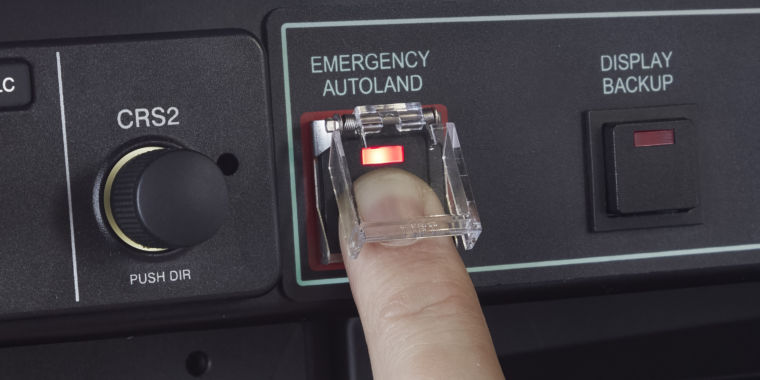https://arstechnica.com/?p=1601331

-
Garmin Avionics has developed an Autoland system to get a General Aviation plane back on the ground if its pilot becomes incapacitated.
Garmin/Piper
-
It’s only currently available in the Piper M600 (previous photo) and the Cirrus Vision, pictured here.
Garmin/Cirrus
-
If you’re in a Piper M600, you’ll need this button.
Garmin/Piper
-
For reference, this is a Piper M600.
Garmin/Piper
-
Don’t touch anything.
Garmin/Piper
-
The system keeps track of any suitable runways you might have flown past on your way.
Garmin/Piper
If you’ve been around long enough, you’ve probably heard stories of passengers who successfully landed small planes after their pilots fell ill or died. It happened in Australia just a few months ago (Aug. 31) when a student on his first flight lesson in Perth was forced to land a Cessna 150 after his instructor lost consciousness.
The student had never landed anything previously, but it worked. However, it usually doesn’t, and the consequences are disastrous. That’s why electronics/avionics maker Garmin is launching Autoland, an emergency autopilot system that can autonomously land a private aircraft and bring it to a stop on the runway.
Push the red button
Commercial airliners have long had auto-landing systems as well as the ability to fall back on co-pilots if the pilot-in-command becomes incapacitated. Until recently, single-pilot certified general aviation (GA) airplanes haven’t had autonomous landing capability. To be clear, they still don’t. Garmin’s Autoland system is not yet FAA certified, though the company expects certification “soon.”
Autoland is a new feature of Garmin’s G3000 integrated flight deck, which already comes with 3-axis autopilot, auto-throttles, and automatic stability and descent capabilities. It will debut on two single-engine airplanes: Piper’s M600 SLS turboprop and Cirrus Aircraft’s Vision Jet. Priced at $2.9 million and $2.3 million, respectively, they admittedly stretch the definition of general aviation aircraft, but each is largely owner-flown.
If you’re aboard one, and the owner-pilot succumbs to something, here’s what happens:
Upon recognizing the pilot is in distress, a passenger can press the Autoland button. In the Cirrus it’s a big red button on the ceiling between the pilot’s seats and at top-center on the M600 instrument panel. The G3000 also monitors pilot activity/inactivity and cabin pressure and can automatically engage Autoland or Emergency Descent Mode if no activity is detected. (Recall the Payne Stewart hypoxia-induced Lear 35 crash.)
The system audibly announces, “Emergency Autoland Activating.” The airplane then declares an emergency with air traffic control via automated voice radio messages and sets the transponder to squawk 7700 (mayday signal).
Simultaneously, Autoland analyzes terrain, weather, and nearby airports to determine the optimal airport for landing given the specific aircraft’s available fuel and performance characteristics, winds, runway length, and a host of other factors. As the airplane descends, Autoland controls speed, altitude and flight path and manages throttles, flaps, cabin pressurization, and more.
Air traffic controllers are informed of the system’s landing destination choice and clear traffic as they would with a human-flown emergency. On final approach, Autoland lowers the gear, flares the airplane, and brings it to a stop with automatic braking. Audible instructions for exiting the airplane then play.
Throughout the evolution, passengers can be in voice contact with ATC, getting reassurance. And if the pilot comes to, they can override Autoland, turning everything off with another press of that button.
Easy to imagine, hard to do
“A lot of this was us trying to figure out what would make sense in this class of aircraft,” says Garmin’s aviation systems team leader, Ben Patel.
Work on the system accelerated four years ago as technology and the business case came together. Garmin’s own development of its autopilot, auto-throttles, and other automated systems formed the building blocks for Autoland.
“These systems that we’re using to enable it are things that have been in the field for years,” Autoland Program Manager Bailey Scheel adds.
Autoland not only employs a sophisticated autopilot, it leverages special routing and destination-selection algorithms. The system is aware of all airports bypassed on a flight as well as those immediately proximate. It actually scores airports for optimal safe landing based on dynamic physical, environmental, and weighted OEM performance parameters.
Senior Software Engineer Eric Tran adds that Autoland routing borrows from Garmin’s automotive autonomy side. “It can choose the best, safest airport for autonomous landing faster than any human pilot.”
Garmin says that about 70% of airports in the US are suitable Autoland destinations. They simply need a GPS approach with vertical guidance.
On the other hand, Autoland requires an airplane with the latest version of the G3000 flight deck, with auto-throttles, auto-braking, radar altimeter, and more. The population of GA aircraft eligible is very small.
As of this writing, Piper has built about 10 Autoland-enabled M600 SLS. Cirrus has two Autoland-equipped Vision Jets. Fitting the system to your private piston-single or twin could be possible with considerable work but also prohibitively expensive. (Garmin declines to price Autoland.)
That’s why Autoland will roll out exclusively on new aircraft for some time to come. Eventually Garmin will broaden the market. In the process, lives will be saved.
Listing image by Garmin/Piper
via Ars Technica https://arstechnica.com
November 13, 2019 at 07:56AM
